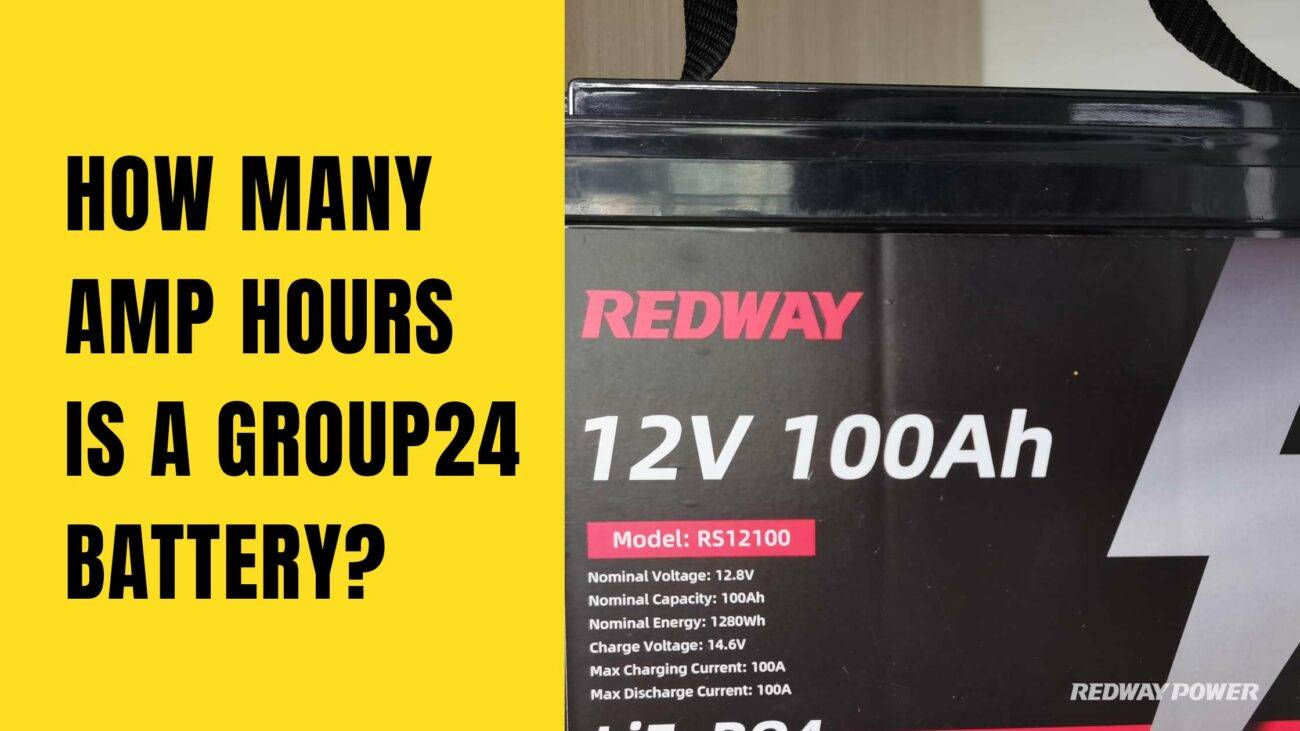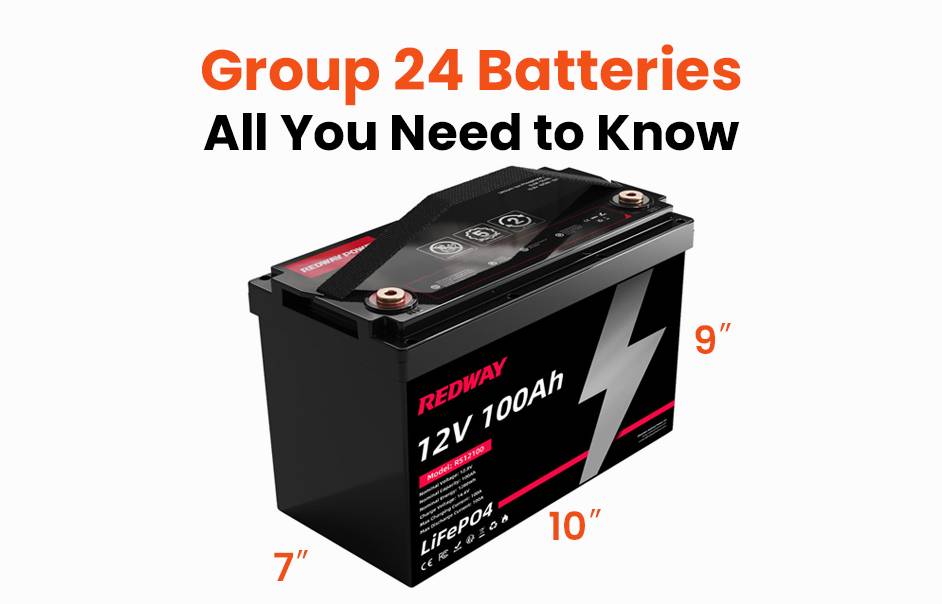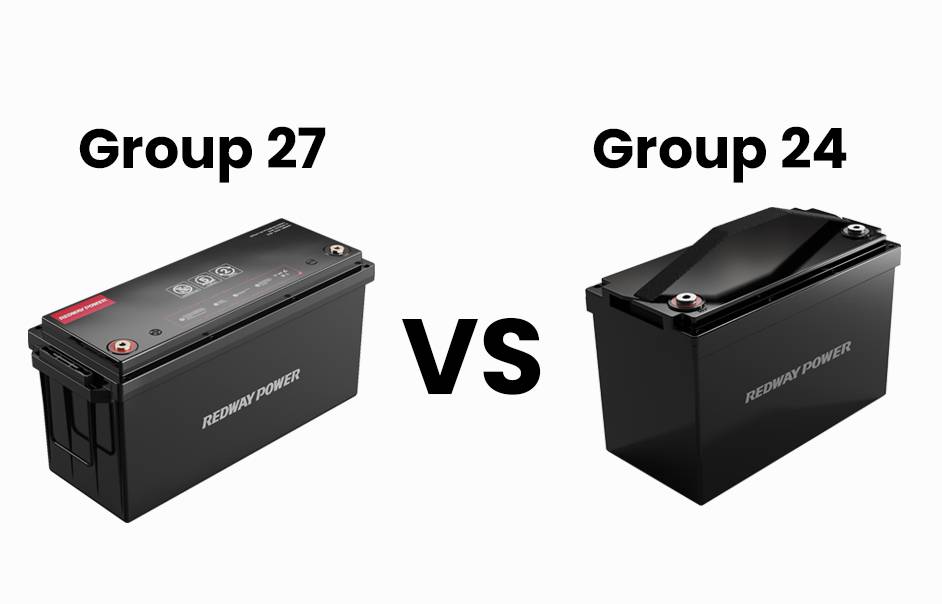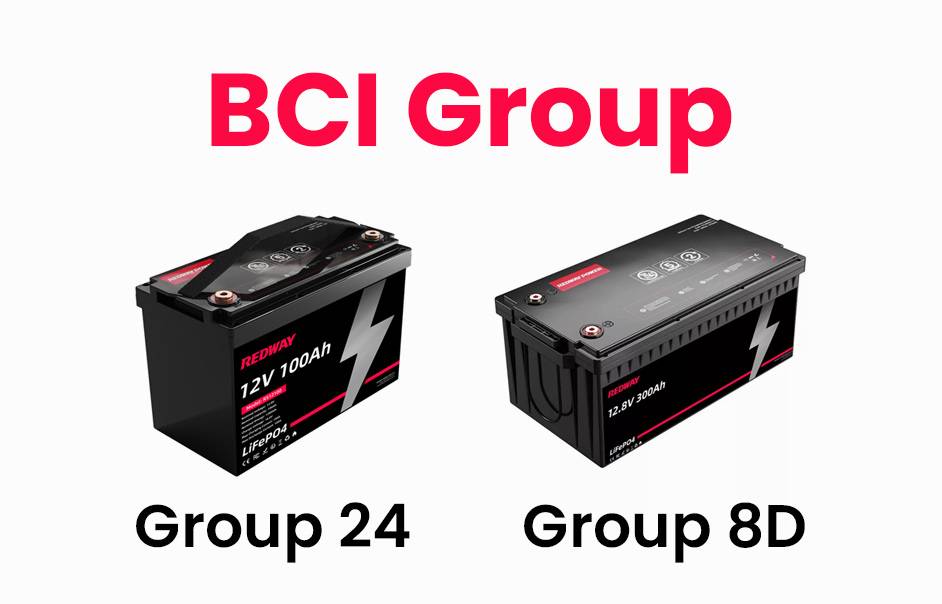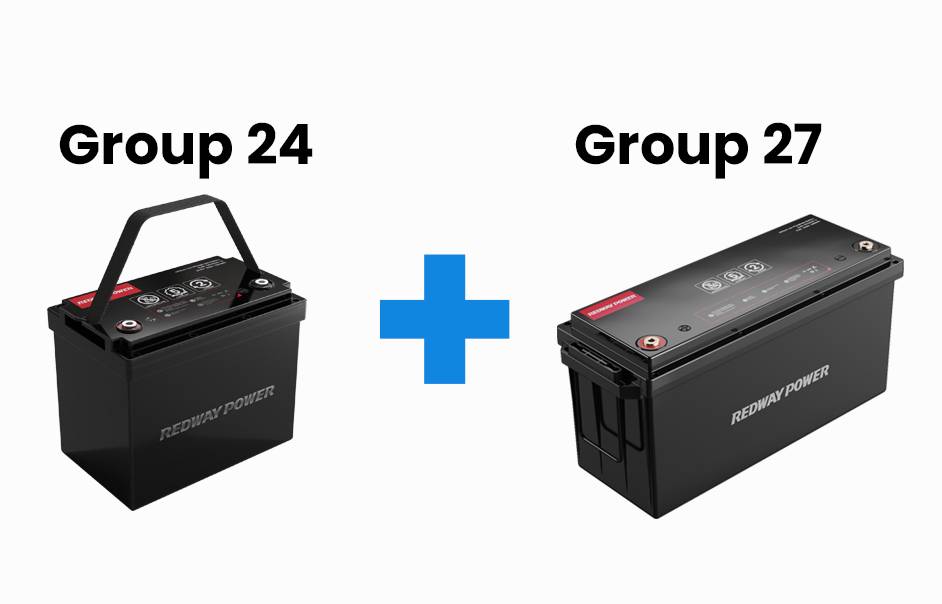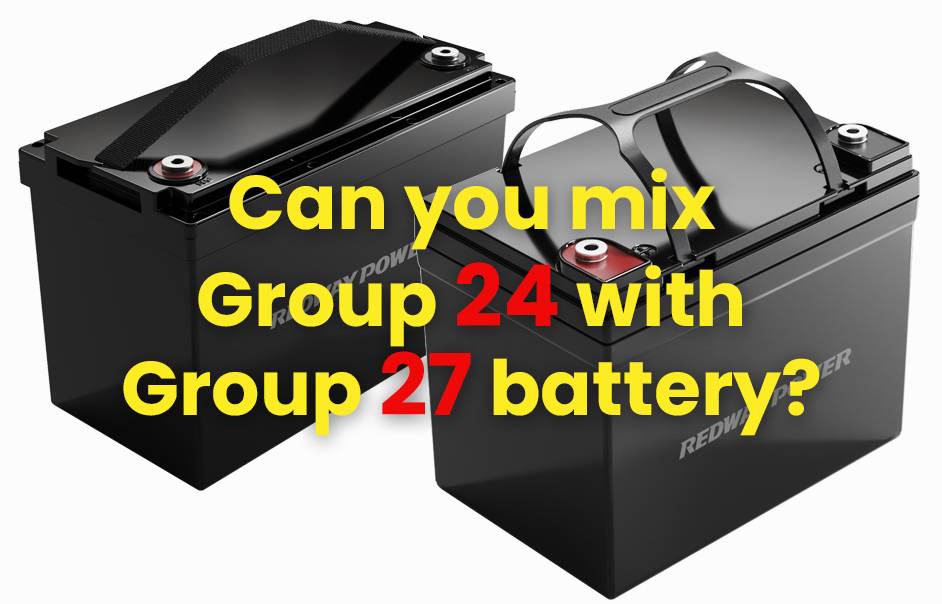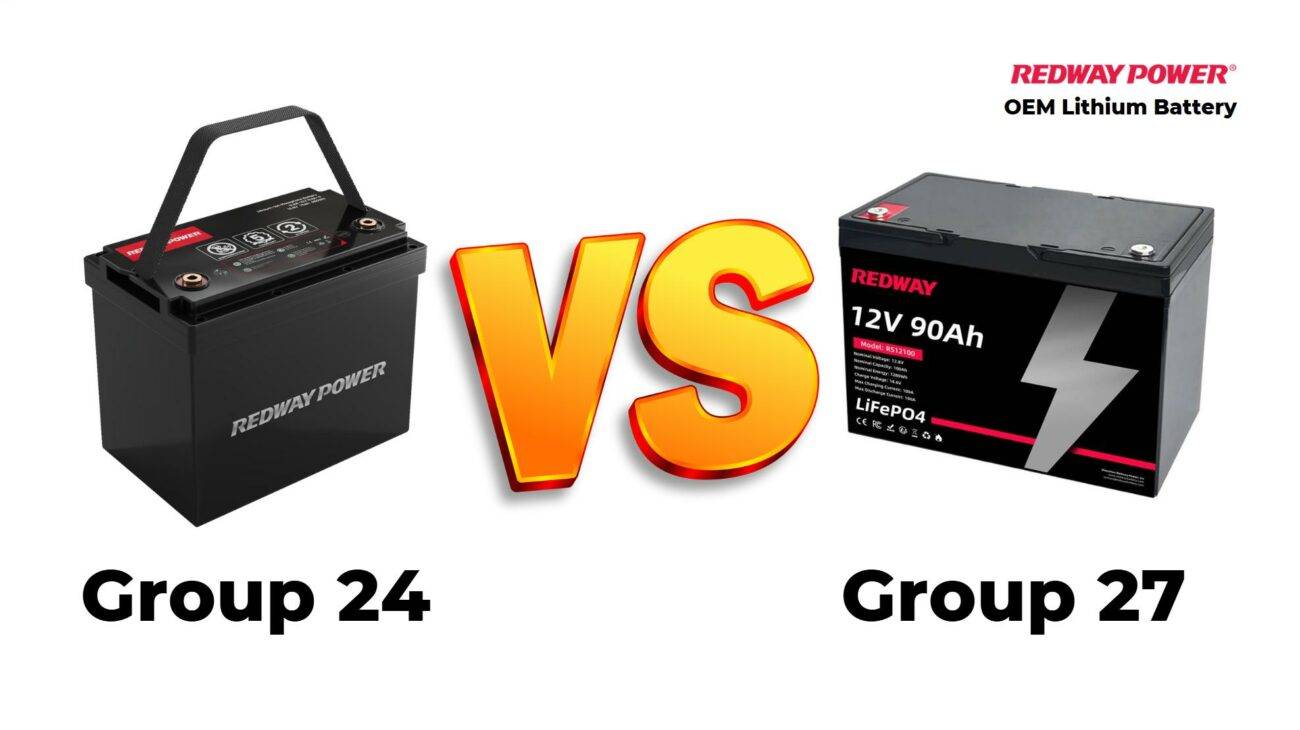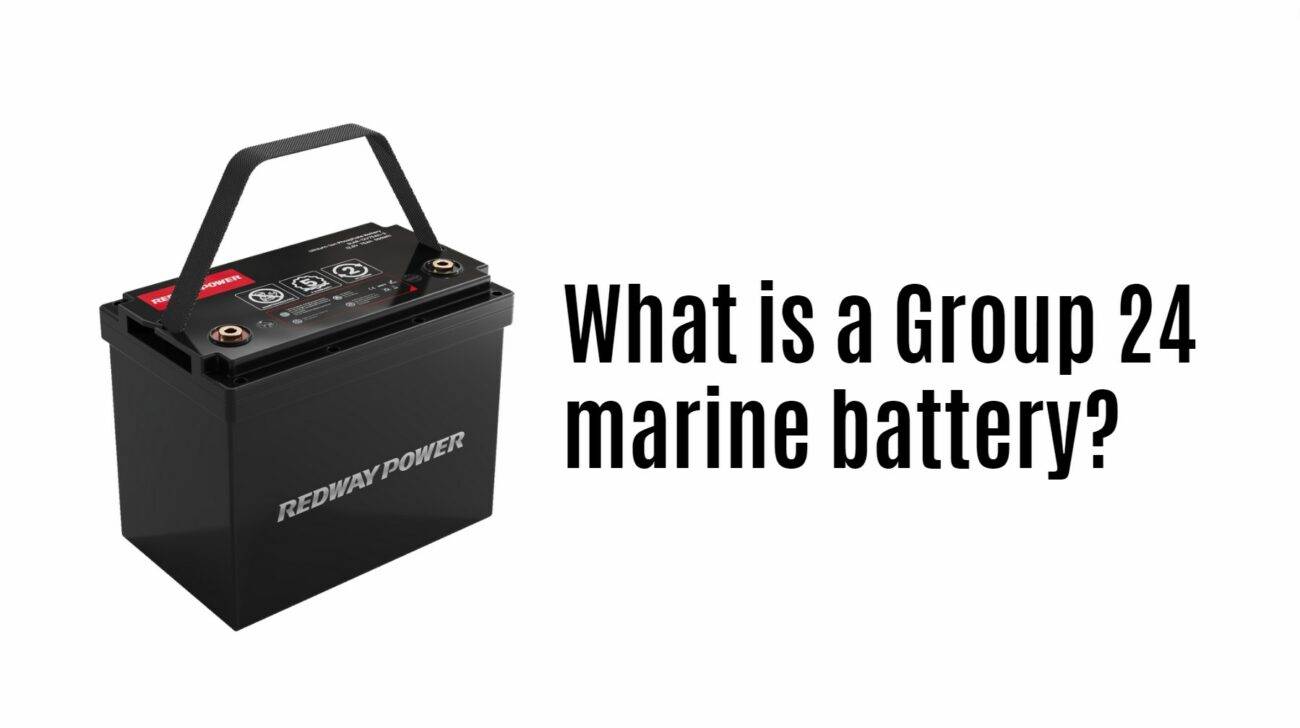- Forklift Lithium Battery
-
48V
- 48V 210Ah
- 48V 300Ah
- 48V 420Ah (949 x 349 x 569 mm)
- 48V 420Ah (950 x 421 x 450 mm)
- 48V 456Ah
- 48V 460Ah (830 x 630 x 590 mm)
- 48V 460Ah (950 x 421 x 450 mm)
- 48V 460Ah (800 x 630 x 600 mm)
- 48V 460Ah (820 x 660 x 470 mm)
- 48V 500Ah
- 48V 560Ah (810 x 630 x 600 mm)
- 48V 560Ah (950 x 592 x 450 mm)
- 48V 600Ah
- 48V 630Ah
-
48V
- Lithium Golf Cart Battery
- 12V Lithium Battery
12V 150Ah Lithium RV Battery
Bluetooth App | BCI Group 31
LiFePO4 Lithium
Discharge Temperature -20°C ~ 65°C
Fast Charger 14.6V 50A
Solar MPPT Charging - 24V Lithium Battery
- 36V Lithium Battery
- 48V Lithium Battery
-
48V LiFePO4 Battery
- 48V 50Ah
- 48V 50Ah (for Golf Carts)
- 48V 60Ah (8D)
- 48V 100Ah (8D)
- 48V 100Ah
- 48V 100Ah (Discharge 100A for Golf Carts)
- 48V 100Ah (Discharge 150A for Golf Carts)
- 48V 100Ah (Discharge 200A for Golf Carts)
- 48V 150Ah (for Golf Carts)
- 48V 160Ah (Discharge 100A for Golf Carts)
- 48V 160Ah (Discharge 160A for Golf Carts)
-
48V LiFePO4 Battery
- 60V Lithium Battery
-
60V LiFePO4 Battery
- 60V 20Ah
- 60V 30Ah
- 60V 50Ah
- 60V 50Ah (Small Size / Side Terminal)
- 60V 100Ah (for Electric Motocycle, Electric Scooter, LSV, AGV)
- 60V 100Ah (for Forklift, AGV, Electric Scooter, Sweeper)
- 60V 150Ah (E-Motocycle / E-Scooter / E-Tricycle / Tour LSV)
- 60V 200Ah (for Forklift, AGV, Electric Scooter, Sweeper)
-
60V LiFePO4 Battery
- 72V~96V Lithium Battery
- Rack-mounted Lithium Battery
- E-Bike Battery
- All-in-One Home-ESS
- Wall-mount Battery ESS
-
Home-ESS Lithium Battery PowerWall
- 24V 100Ah 2.4kWh PW24100-S PowerWall
- 48V 50Ah 2.4kWh PW4850-S PowerWall
- 48V 50Ah 2.56kWh PW5150-S PowerWall
- 48V 100Ah 5.12kWh PW51100-F PowerWall (IP65)
- 48V 100Ah 5.12kWh PW51100-S PowerWall
- 48V 100Ah 5.12kWh PW51100-H PowerWall
- 48V 200Ah 10kWh PW51200-H PowerWall
- 48V 300Ah 15kWh PW51300-H PowerWall
PowerWall 51.2V 100Ah LiFePO4 Lithium Battery
Highly popular in Asia and Eastern Europe.
CE Certification | Home-ESS -
Home-ESS Lithium Battery PowerWall
- Portable Power Stations
BCI Group 24 Batteries, Comprehensive Guide
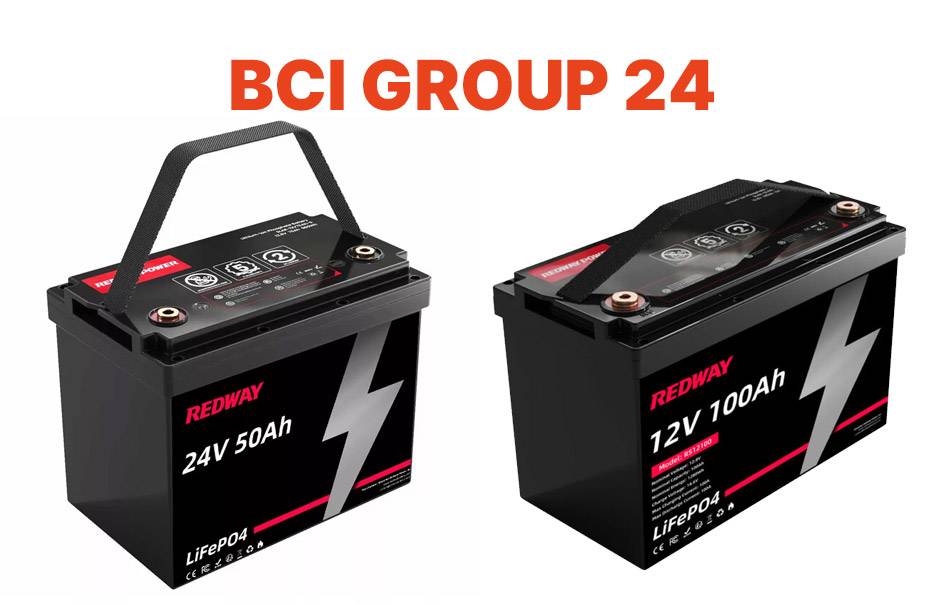
BCI Group 24 batteries are versatile power sources commonly found in cars, trucks, RVs, boats, and marine applications. With standardized sizing and reliability, they provide essential electrical power for starting engines and running onboard systems.
What are BCI Group 24 Batteries?
BCI Group 24 batteries are commonly used in cars, trucks, RVs, boats, and marine applications. They provide reliable power for starting engines and running onboard systems. With dimensions of approximately 10.25 x 6.8125 x 8.875 inches (260 x 173 x 225 mm), it’s important to choose the correct subgroup for proper fitment. BCI Group 24 batteries offer versatility and dependable performance for various automotive and marine applications. Check 12V 100Ah Lithium LiFePO4 Battery (Group 24)
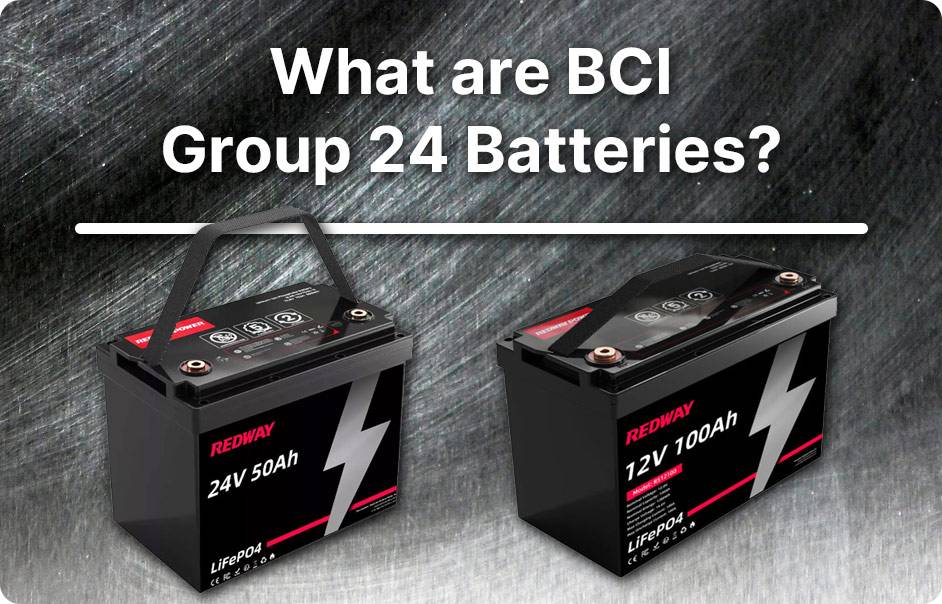
| BCI Group Size | L (mm) | W (mm) | H (mm) | L (inch) | W (inch) | H (inch) | Redway Power LiFePO4 Battery |
| 24 | 260 | 173 | 225 | 10 1/4 | 6 13/16 | 8 7/8 | Group 24 Battery |
| 24F | 273 | 173 | 229 | 10 3/4 | 6 13/16 | 9 | Group 24F Battery |
| 24H | 260 | 173 | 238 | 10 1/4 | 6 13/16 | 9 3/8 | Group 24H Battery |
| 24R | 260 | 173 | 229 | 10 1/4 | 6 13/16 | 9 | Group 24R Battery |
| 24T | 260 | 173 | 248 | 10 1/4 | 6 13/16 | 9 3/4 | Group 24T Battery |
Please note: Amazon affiliate links in the chart open in new windows for your convenience.
The physical dimensions of Group 24 batteries closely resemble several other battery groups, allowing for versatile interchangeability. Here are the maximum dimensions (L x W x H) of some related groups:
- Group 78: 10.25 x 7.0625 x 7.6875 inches (26 x 17.9 x 19.6 cm)
- Group 34: 10.25 x 6.8125 x 7.875 inches (26 x 17.3 x 20 cm)
- Group 24: 10.25 x 6.8125 x 8.875 inches (26 x 17.3 x 22.5 cm)
Group 24 batteries are widely available at hardware and automotive stores, as well as online retailers. If you require a new Group 24 battery, it’s readily accessible.
What are advantages of BCI Group 24 batteries?
BCI Group 24 batteries offer versatility and reliable performance. They are commonly used in cars, trucks, RVs, and boats. With standardized sizing, they ensure proper fitment. Group 24 batteries provide essential starting power and run onboard systems. These advantages make them a reliable choice for various applications.
- Versatility: BCI Group 24 batteries are versatile and can be used in a wide range of vehicles, including cars, trucks, RVs, boats, and marine applications. They are suitable for both starting and deep-cycle applications, making them a versatile option for various vehicles and systems.
- Standardized Size: Group 24 batteries have standardized dimensions, making them easy to install and replace. This standardization ensures compatibility with a wide range of vehicles and battery compartments.
- Available Options: BCI Group 24 batteries are available in different chemistries, including lead-acid, AGM (Absorbent Glass Mat), and lithium-ion. This allows you to choose the battery type that best suits your vehicle’s requirements and performance needs.
- Reliable Performance: Group 24 batteries offer reliable performance, with specifications such as nominal capacity (Ah), cold cranking amps (CCA), marine cranking amps (MCA), and reserve capacity (RC) meeting the demands of various applications. They provide sufficient power to start the engine, run electronic accessories, and power onboard systems reliably.
- Widely Available: BCI Group 24 batteries are widely available at automotive stores, online retailers, and battery distributors, making them easy to find and purchase when needed. This ensures convenience and accessibility for vehicle owners.
Overall, choosing a BCI Group 24 battery provides a reliable, versatile, and readily available power solution for your vehicle’s electrical needs.
What vehicles typically use BCI Group 24 batteries?
BCI Group 24 batteries are commonly used in cars, trucks, RVs, boats, and other applications where reliable power is required. Their standardized size and versatility make them popular across different vehicle types. These batteries provide a dependable power source for various vehicles and ensure efficient performance. BCI Group 24 batteries are a trusted choice for reliable power in automotive and marine applications.
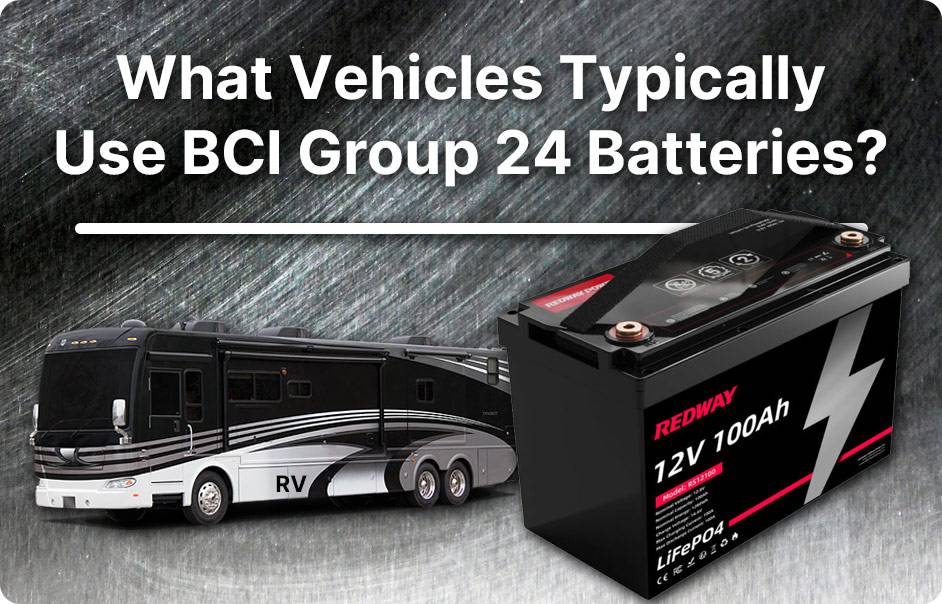
- Cars: Some mid-size to larger cars, particularly those with higher electrical demands or optional accessories, may utilize Group 24 batteries to provide starting power and electrical energy.
- Light Trucks: Certain light trucks, including pickups and vans, may use Group 24 batteries to meet their starting and electrical power requirements.
- Marine and RVs: Group 24 batteries are often employed in marine vessels and recreational vehicles (RVs) to power onboard electronics, lights, and other accessories.
- Golf Carts: Electric golf carts frequently use Group 24 batteries to provide the necessary electrical power for propulsion and accessories.
- Industrial Equipment: Some light industrial equipment, such as forklifts and utility vehicles, may utilize Group 24 batteries for their electrical systems.
Overall, BCI Group 24 batteries are versatile and suitable for a range of applications, making them a popular choice for vehicles and equipment with moderate power demands.
How do BCI Group Sizes align with international battery standards such as DIS, EN, and JIS sizes?
BCI Group Sizes standardize batteries based on size, performance, terminal placement, and chemistry. They match international standards like DIS, EN, and JIS, ensuring batteries fit and function properly across different regions and vehicles. This makes it easier to find compatible batteries worldwide.
BCI Group Sizes ensure that batteries fit and work correctly in cars and other devices. Here’s a detailed explanation:
- Standardized Sizes:
- Uniform Dimensions: Each BCI Group Size has specific measurements that must be consistent within 2mm. This ensures that batteries fit properly in different vehicles.
- Global Compatibility: A Group 24 battery in the U.S. will have the same dimensions as one in Europe, making replacements straightforward.
- Performance Metrics:
- Cold Cranking Amps (CCA): This measures how well a battery can start an engine in cold temperatures. For example, older cars might need a battery with high CCA to start reliably in winter.
- Amp Hours (Ah): This indicates how much charge a battery can hold and deliver over time, important for newer vehicles and electric cars that require sustained power.
- Terminal Placement:
- Correct Connections: The position of the terminals (positive and negative posts) is standardized so they connect properly to the car’s electrical system.
- Example: Whether you’re using a battery labeled under BCI, DIS, EN, or JIS standards, the terminals will align correctly with the vehicle’s connections.
- Battery Chemistry:
- Variety of Types: BCI Group Sizes include different battery chemistries such as lead-acid, EFB, AGM, and lithium-ion (LFP). Each type has unique properties, like lifespan and maintenance needs, to suit various vehicle requirements.
- Consistency Across Types: Regardless of the chemistry, batteries within the same BCI Group Size will meet the same physical and performance criteria.
In summary, BCI Group Sizes make it easy to find the right battery for your vehicle, no matter where you are. By matching international standards, they ensure compatibility and reliable performance across different regions and types of vehicles.
Best Sellers of BCI Group 24 Batteries in 2024
Below is a chart featuring some of the most popular BCI Group 24 batteries:
| Model | Battery Type Chemistry |
Capacity(Ah) RC (min) |
CCA MCA |
Weight (lbs/kg) Review |
| ACDelco M24AGM | Deep Cycle AGM |
80 140 |
500 625 |
43.0 lbs; ~19.5 kg |
| Battle Born BB1250 | Deep Cycle LiFePO4 |
50 120 |
60A const. 100A 30s |
22 lbs; 9.96 kg |
| Battle Born BB1275 | Deep Cycle LiFePO4 |
75 180 |
100A const. 200A 30s |
27 lbs; 12.23 kg |
| Exide Edge FP-AGM24DP | Dual Purpose AGM |
75 145 |
775 930 |
50 lbs; ~22.7 kg |
| Lifeline GPL-24T | Deep Cycle AGM |
80 149 |
550 680 |
56 lbs; 25.5 kg |
| LiTime 12V 100Ah Mini | Deep Cycle LiFePO4 |
100 240 |
100A cont. 250A 5 sec |
19 lbs; 8.6 kg |
| Mighty Max ML75-12 | Deep Cycle AGM |
77 – |
– – |
50.71 lbs; ~22.97 kg |
| Mighty Max ML75-12 Gel | Deep Cycle Gel |
75 – |
– – |
50.55 lbs; 22.9 kg |
| NorthStar NSB-AGM24F | Dual Purpose AGM |
76 160 |
840 1000 |
57 lbs; ~25.8 kg |
| Power Sonic PS-12750 | Deep Cycle AGM |
78 – |
900A 5s | 50.6 lbs; 22.9 kg |
| UPG UB12750 | Deep Cycle AGM |
75 – |
– – |
49.1 lbs; ~22.3 kg |
| VMAXTANKS FLP24-1265 | Deep Cycle LiFePO4 |
65 ~150 |
65A const. 120A 3s. |
15.5 lbs, 7.0 kg |
| VMAXTANKS MB107-85 | Deep Cycle AGM |
85 170 |
– – |
55 lbs; ~24.9 kg |
| VMAXTANKS MR107-85 | Deep Cycle AGM |
85 160 |
– 700 |
55 lbs; ~24.9 kg |
| VMAXTANKS SLR-85 | Deep Cycle AGM |
85 180 |
– – |
55 lbs; ~24.9 kg |
| Weize FP12750/TL1275 | Deep Cycle AGM |
77 – |
– – |
46 lbs; 20.9 kg |
Please note: Amazon affiliate links in the ‘Model’ column open in new windows for the most up-to-date prices and offers.
BCI Group 24 batteries predominantly consist of deep-cycle and dual-purpose batteries commonly employed in vehicles equipped with dual battery systems.
Can I Use Group 34 Batteries to Replace Group 24 Batteries?
When replacing a Group 24 battery with a Group 34 battery, consider the physical size and terminal positions. Group 34 batteries are slightly smaller but can fit in most Group 24 battery boxes. Ensure the Cold Cranking Amps (CCA) rating is the same or higher to avoid starting issues. The Reserve Capacity (RC) rating is similar for both battery groups. Group 34 batteries are commonly used in cars, SUVs, and trucks and can replace Group 24 batteries with proper consideration.
| Model | Battery Type Chemistry |
Capacity RC |
CCA MCA |
Weight (lbs/kg) Review |
| ACDelco 34AGM | Starting AGM |
60 115 |
740 – |
38.7 lbs; 17.4 kg – |
| Banshee 34M | Dual Purpose Flooded |
66 100 |
750 870 |
37.0 lbs; 16.8 kg – |
| Banshee LFP-34M | Dual Purpose LiFePO4 |
50 ~120 |
800 – |
13.8 lbs; 6.25 kg – |
| Deka 9A34 | Dual Purpose AGM |
55 120 |
750 955 |
41 lbs; 18.6 kg – |
| Delphi BU9034 | Starting AGM |
55 120 |
775 – |
42.5 lbs; 19.3 kg – |
| DieHard 38232 | Starting AGM |
55 120 |
775 – |
44.5 lbs; 20.2 kg |
| Exide Edge FP-AGM34 | Dual Purpose AGM |
60 120 |
770 – |
45.9 lbs; 20.8 kg – |
| Interstate MTZ-34 | Starting AGM |
63 125 |
800 1000 |
47 lbs; 21.3 kg – |
| Interstate MTZ-34R | Starting AGM |
63 125 |
800 1000 |
47 lbs; 21.3 kg – |
| Mighty Max ML-GROUP34 | Deep Cycle AGM |
60 – |
– | 39.7 lbs; 18 kg – |
| NorthStar NSB-AGM34 | Dual Purpose AGM |
65 134 |
880 1050 |
51 lbs; 23.1 kg – |
| NorthStar NSB-AGM34/78 | Dual Purpose AGM |
65 134 |
880 1050 |
51 lbs; 23.1 kg – |
| Odyssey 34-PC1500T | Dual Purpose AGM |
68 135 |
850 1050 |
49.5 lbs; 22.4 kg |
| Optima RedTop 34 | Starting AGM |
50 100 |
800 1000 |
37.9 lbs; 17.2 kg |
| Optima 8016-103 D34M | Dual Purpose AGM |
55 120 |
750 870 |
43.5 lbs; 19.7 kg |
| VMAXTANKS XTR34-75 | Deep Cycle AGM |
75 145 |
– 825* |
45.0 lbs; 20.4 kg |
| Weize 34M Dual Purpose | Dual Purpose AGM |
55 120 |
650 780 |
42.6 lbs; 19.3 kg – |
| XS Power D3400 12V 65 Ah | Dual Purpose AGM |
65 135 |
– 1000 |
47.0 lbs; 21.32 kg |
| XS Power D3400 12V 80Ah | Dual Purpose AGM |
80 160 |
– 1150 |
50 lbs; 22.67 kg |
Please note: Amazon affiliate links in the ‘Model’ column open in new windows for the most up-to-date prices and offers.
BCI Group 24 batteries typically offer a nominal capacity of 75-85 Ah, 500-840 CCA, 625-1000 MCA, and RC values between 140 and 180 minutes.
In contrast, BCI Group 34 batteries have a nominal capacity ranging from 50 to 80 Ah, 740 to 880 CCA, 825 to 1150 MCA, and RC values between 100 and 160 minutes.
It’s important to highlight that although the VMAXTANKS XTR34-75 is considered a deep cycle battery, it boasts an impressive 1100 HCA (Hot Cranking Amps). The MCA value of 825 Amps is calculated using the formula:
MCA = HCA x 0.75 = 1100 Amps x 0.75 = 825 Amps
This approximation demonstrates the battery’s robustness and strength.
While it’s technically possible to use a Group 34 battery as a replacement for a Group 24 battery, there are some factors to consider:
- Size and Fitment: Group 34 batteries are typically smaller in size compared to Group 24 batteries. Ensure that the Group 34 battery fits properly in the battery compartment of your vehicle without any modifications.
- Performance: Group 34 batteries may have different specifications, including capacity, CCA (Cold Cranking Amps), and RC (Reserve Capacity), compared to Group 24 batteries. Ensure that the replacement battery meets or exceeds the requirements of your vehicle for reliable performance.
- Intended Use: Group 24 batteries are commonly used in both starting and deep-cycle applications. If your vehicle requires a deep-cycle battery, ensure that the Group 34 battery you choose is suitable for this purpose.
- Consultation: It’s always recommended to consult your vehicle’s manual or a professional technician before substituting one battery size for another. They can provide guidance on compatibility and ensure that the replacement battery meets the specific requirements of your vehicle.
In summary, while Group 34 batteries can be used as replacements for Group 24 batteries, careful consideration of size, performance, and intended use is essential to ensure compatibility and reliable operation in your vehicle.
What vehicles commonly use Group 24 batteries?
Group 24 batteries are commonly used in cars, light trucks, RVs, motorcycles, ATVs, golf carts, and smaller boats. They strike a balance between size, strength, and cost, making them versatile for moderate power demands. These batteries are widely available and provide reliable power for a variety of vehicles and recreational equipment.
What are the dimensions of a Group 24 battery?
A Group 24 battery typically measures around 10.3 inches in length, 6.8 inches in width, and 9.4 inches in height. These standardized dimensions ensure that the battery fits properly in the designated compartments of vehicles or systems. Group 24 batteries are commonly used in various applications, including vehicles and backup power systems. They are often preferred for deep cycle use rather than starting engines.
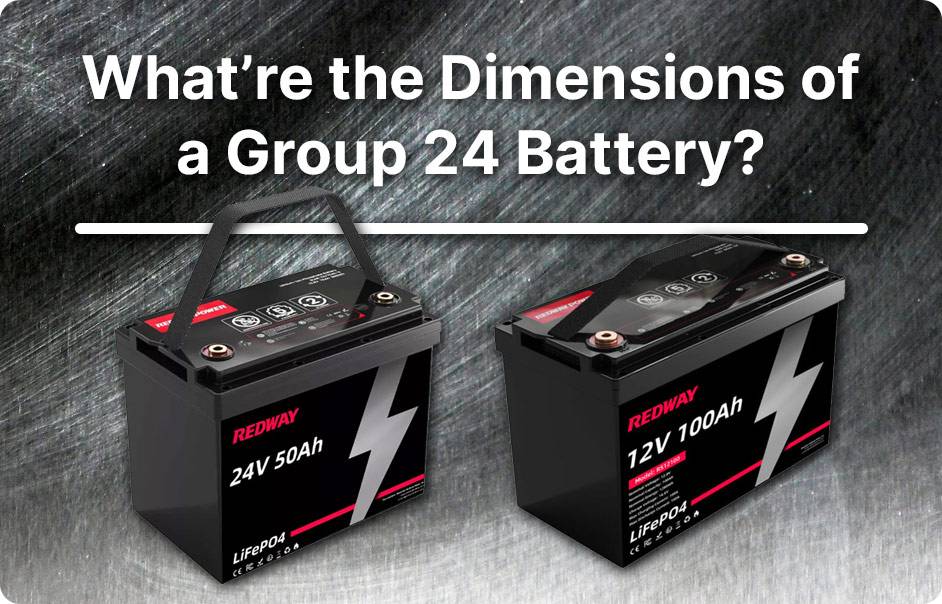
What is the capacity of a Group 24 battery?
A Group 24 battery typically has a capacity of around 70-85 amp-hours (Ah). This capacity makes it suitable for both engine starting and auxiliary functions. Group 24 batteries provide the necessary power to start the engine and also support additional electrical needs in vehicles. With their reliable capacity, they are a common choice for various automotive applications.
Are Group 24 batteries suitable for deep cycle applications?
Group 24 batteries are primarily used for engine starting and auxiliary power, rather than deep cycle applications. For deep cycle needs like marine trolling motors or RV house batteries, it is recommended to consider batteries specifically labeled as deep cycle or dual-purpose. These batteries are designed to withstand the demands of deep cycle use and provide reliable performance.
How long do Group 24 batteries typically last?
The lifespan of Group 24 batteries varies but typically lasts around 3 to 5 years. Factors such as usage, maintenance, and battery quality can affect their longevity. To extend their life, it is important to regularly charge the battery, install it correctly, and avoid deep discharges. Taking these precautions can help ensure the battery’s optimal performance and longevity.
Can I replace my current battery with a Group 24 battery if my vehicle originally had a different battery size?
Yes, you can replace your current battery with a Group 24 battery, even if your vehicle originally had a different battery size. Make sure the Group 24 battery fits securely in the designated compartment and has the necessary performance specifications for your vehicle. It’s important to ensure a proper fit and performance to avoid any potential issues.
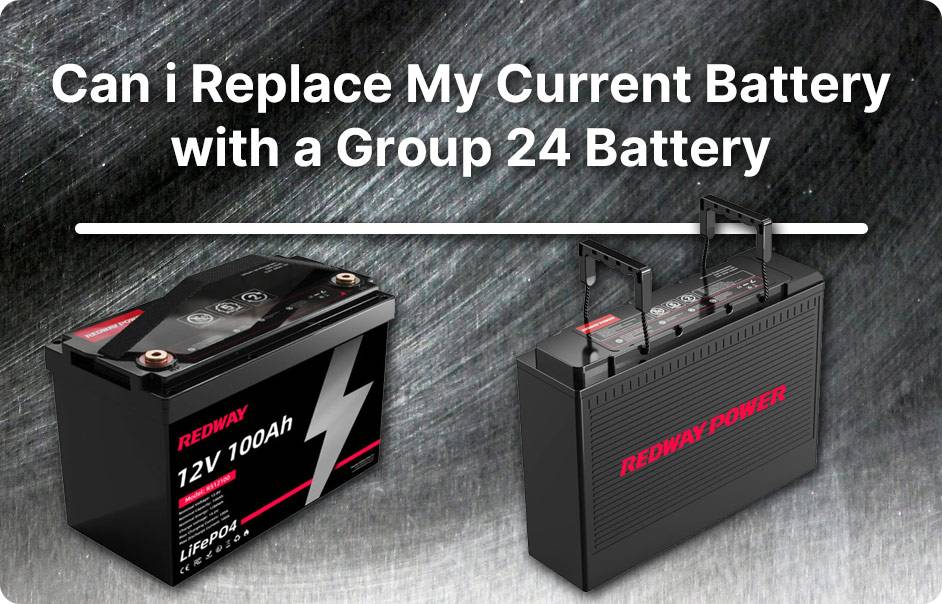
FAQs
What is BCI Group 24?
BCI Group 24 refers to a standardized battery size, typically used in applications like marine, RVs, and some vehicles. It specifies physical dimensions and terminal configurations.
What is a BCI group battery?
A BCI group battery is categorized by the Battery Council International (BCI) based on size, shape, and terminal placement, ensuring compatibility with various vehicles and devices.
What is the equivalent of a group 24 battery?
Equivalent batteries to a group 24 battery may include group 27 batteries, but it’s essential to check size, capacity, and compatibility before replacement.
What does BCI stand for in batteries?
BCI stands for Battery Council International, an organization that establishes standards for battery sizes and performance.
What is BCI rating?
BCI rating refers to a battery’s classification based on its dimensions, terminal placement, and compatibility, aiding consumers in selecting the right battery for their needs.
What does BCI stand for?
BCI stands for Battery Council International, which provides standards and guidelines for battery manufacturers and users.
How long will a group 24 battery last?
The lifespan of a group 24 battery varies based on usage and maintenance but typically lasts 3 to 5 years under normal conditions.
What does 24 mean on a battery?
The “24” in a battery’s designation indicates its group size, which relates to its physical dimensions and intended applications.
Can you replace a group 24 battery with a group 27?
Yes, you can replace a group 24 battery with a group 27 battery if the larger size fits your battery compartment and the power requirements are compatible.
What is BCI Group U1?
BCI Group U1 is a designation for a small, lightweight battery commonly used in lawn and garden equipment, wheelchairs, and other applications requiring compact power.
Are Group 24 and 34 batteries the same?
No, Group 24 and Group 34 batteries differ in size and capacity. Group 24 batteries are generally larger than Group 34 batteries.
How many Ah is a group 24 battery?
A group 24 battery typically has a capacity ranging from 60 to 85 Ah, depending on the specific model and manufacturer.
What are BCI groups?
BCI groups classify batteries into standardized categories based on size, terminal placement, and performance, facilitating easier selection for various applications.
What is BCI used for?
BCI standards are used to ensure compatibility and safety in battery applications, helping consumers and manufacturers identify the right battery types for specific needs.
Is a group 27 battery better than a group 24?
A group 27 battery is generally better in terms of capacity and power, as it is larger and can provide more amp-hours, making it suitable for higher-demand applications.















